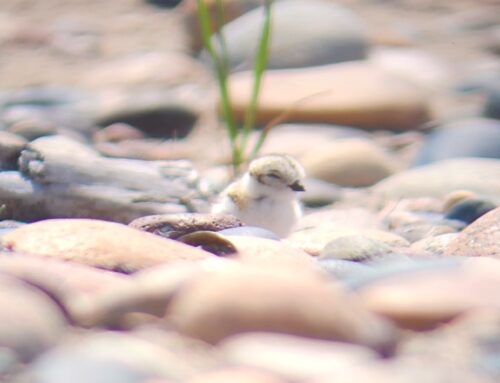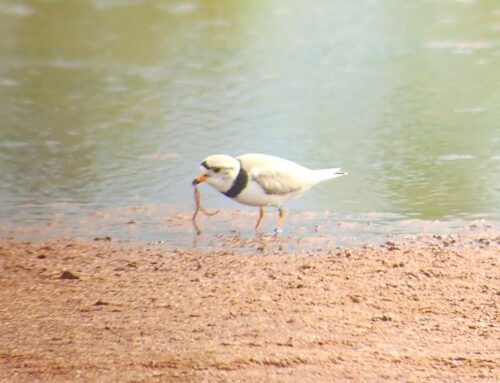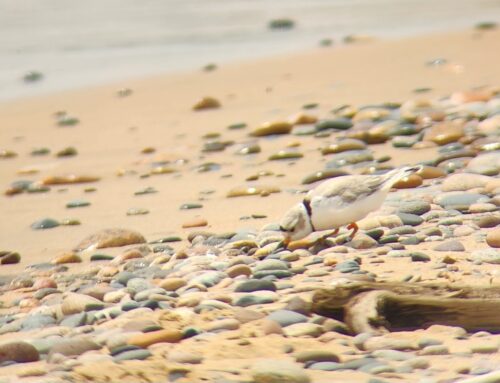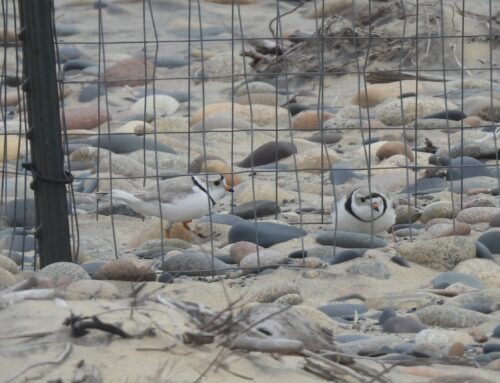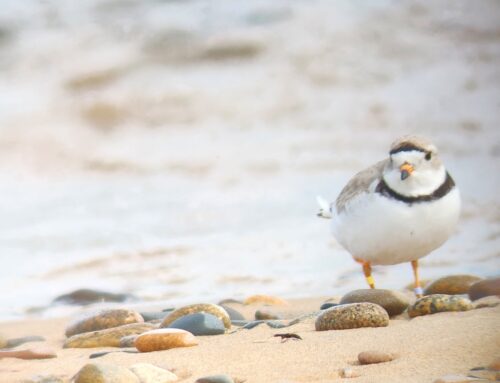Here are three bits of exciting news from WPBO this past week:
1. We received three juvenile Piping Plovers from the Great Lakes Piping Plover captive rearing program! Since 1992, eggs from nests compromised by storm surge, parent plover mortality, or “side chick” situations (yes, that’s exactly what you think it is!) have been salvaged, incubated, and raised at the University of Michigan Biological Station near Pellston. This is a joint project with the Detroit Zoo; in fact, this year, because of Covid-19 implications, the captive-rearing process happened entirely at the Detroit Zoo. A record number (40!) of chicks have been hatched through this year’s captive-rear program, and the Leelanau Ticker recently gave a great recap of the season.

One of the captive-reared YO gang. Vilag photo.
Some of you will remember that our nesting male this year, Zombie Chick, was a 2019 captive-reared chick released at WPBO last summer; I would be delighted if some of these new releases come back to nest next year, because our beach is too nice to host just one pair! We’ve been calling our new juveniles the “Yo Gang,” after their split Yellow/Orange band. The Yo Gang are originally from a Wilderness State Park nest, and they seem quite content in their new home, and there haven’t been undue turf wars. In fact, this morning, our chicks and the captive juveniles were feeding together on the beach. I’m loving how many Piping Plovers we’ve got at the Point right now!
2. Our Piping Plover chicks fledged! Officially, plover chicks are classified as fledged 23 days after they hatch, which was this past Sunday, July 26th. This was a very foggy day out on the Point, which makes everything feel more intimate. It was just me and the waves and the plovers–and, right on schedule, the chicks were flying…sort of! They weren’t getting much height, and landings and steering were charmingly haphazard; the chicks seemed both incredulous and a little anxious about their new abilities. Watching it all, I was surprisingly overwhelmed. 23 days of channeling maternal instincts is about my limit, and I am overjoyed and a bit relieved that the chicks made it to this new stage of independence. The chicks are also quite cheeky and full of themselves, and attempt to chase off every migrant shorebird they catch sight of–even much larger species. Last weekend, a photographer visiting the point saw the chick take a pass at a Least Sandpiper, which, unperturbed, responded by bowling the chick over. I wish I’d been there to see it…

Piping Plover, 4 days old. Vilag photo.

Piping Plover, 25 days old. Vilag photo.
3. And…speaking of migration…it is on again! My own migratory restlessness kicks into high gear about this time of year: every time I walk the beach, there’s a different configuration of shorebirds stopped over (which tempts excessive amounts of walks around the point); when I was biking out yesterday morning, the road was lined more with warbler chips than it was with warbler song; a brisk northwest wind propelled 546 Red-necked Grebes past the Point yesterday, July 27th! (Hannah spotted our first July 26th.) The Red-necked Grebes are the first of WPBO’s flagship fall waterbird species to move through in great numbers (average/fall count is nearly 12,500, with the record being 18,577 from 2010). While their fall migration past Whitefish Point is not one of our more blatantly charismatic flights (most grebes are very distant–which is why I don’t have a photo for you; they travel in small flocks; and, with spindly necks and oversized feet, they appear quite ungainly in flight), the fall Red-necked Grebes are, in fact, one of our most unique movements. They are in transit from northwestern Canada, bound for the Bay of Fundy, and–en route–the grebes stop to molt their flight feathers in remote parts of northern Lake Huron, for example off Manitoulin Island. WPBO records far more of this species in fall than any other North American waterbird watch.
While the calendar on the wall tells me it’s late July–conventionally, summer– observations and zugunruhue both inside and out suggest otherwise. Thank you, as always, for reading.
–Alison Vilag, WPBO Outreach Specialist & Piping Plover Monitor

Sunset on our first grebe night flight of the fall. Vilag.


